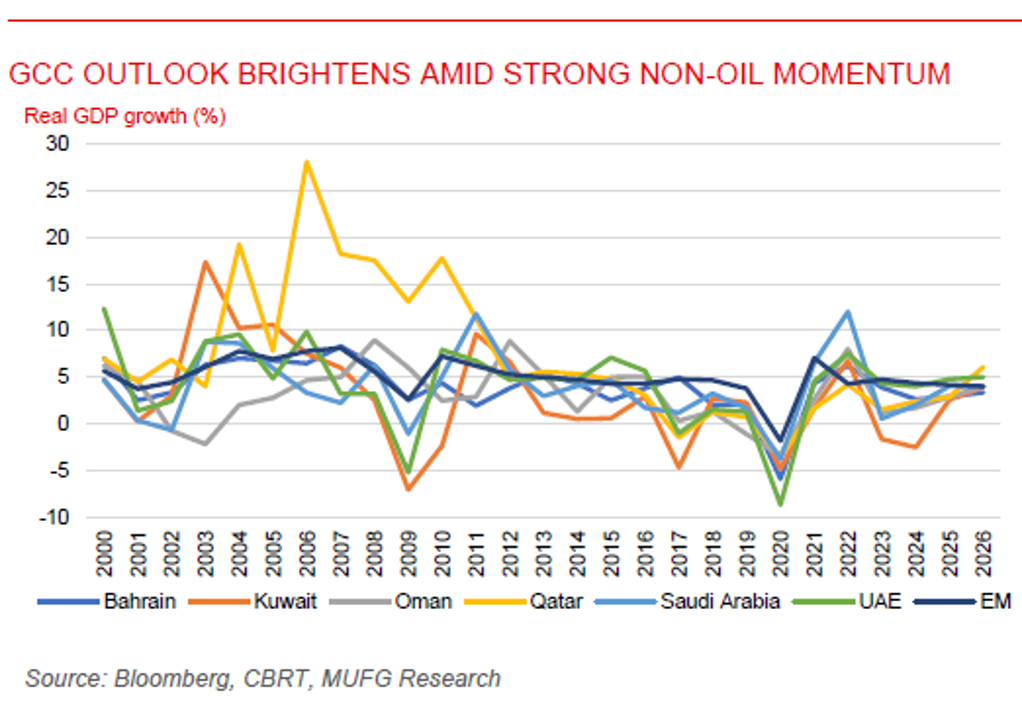To read the full report, please download the PDF above.
Middle East Daily
SOOJIN KIM
Research Analyst
DIFC Branch – Dubai
T: +44(4)387 5031
E: soojin.kim@ae.mufg.jp
MUFG Bank, Ltd. and MUFG Securities plc
A member of MUFG, a global financial group
Middle East Daily
COMMODITIES / ENERGY
Oil rises on prospects of US-India trade deal and reduced Russian imports. Oil prices climbed after reports suggested the US and India are close to finalising a trade deal that could see India gradually cut imports of Russian crude, potentially lifting demand for other grades. Brent rose 1.9% above USD62/b, while WTI neared USD59/b. the agreement may also include lower tariffs on Indian exports, easing trade tensions. President Tump said Prime Minister Modi had pledged to scale back Russian oil purchases, though Indian refiners signalled hey would only partially reduce imports. Despite the rebound, oil remains on course for a third consecutive monthly loss amid persistent oversupply. Going forward, market sentiment will hinge on the outcome of the trade talks and broader supply-demand dynamics.
Gold and silver retreat sharply after overextended rallies. Gold and silver prices fluctuated following their steepest declines in years, as concerns grew that their rapid rallies had pushed valuations too high. Spot gold hovered near USD4,140/oz after plunging over 6%, its biggest one-day drop in more than a decade, while silver rebounded slightly after an 8.7% slide. The correction halted a powerful surge since mid-August fuelled by the “debasement trade”, investor hedging against US deficits, and expectations of a major Fed rate cut. Despite the selloff, gold remains up nearly 60% this year, supported by continued central bank buying and inflows into gold-backed ETFs. The pullback also coincided with optimism over renewed US-China trade talks and a lack of Commodity Futures Trading Commission positioning data due to the US shutdown, heightening speculative volatility. Going forward, precious metals are likely to remain volatile as markets recalibrate after months of overheated gains.
MIDDLE EAST - CREDIT TRADING
End of day comment – 21 October 2025. Strong day in cash and spread performance. Off the gate sovereign bonds got bid up especially the ADGB curve today. Later in the morning Quasis joined as well as recent new fins issues which had underperformed. The market peaked around midday when spreads where 5/8bp tighter. The afternoon saw flows turning more mixed and with UST moving higher spreads widened a touch from the tights. Long end bonds are still the strongest part of the curve and ADGB and QATAR long end broke the 5% yield level today. ADGB 54 +1pt/-4bp, QATAR 48s +0.875pt/-4bp were the outperformers. Quasi sovereign saw a lot of ETF inflows and started to move more in line with the sovereign, ADQABU 34s closing +0.5pt/-4bp for example with most household names 0.25/0.625pt higher and 3/5bp tighter. It was finally also the day were recent new issues which had underperformed found a bid, most prominently DHBKQD 31s which traded in a 98.75/875 range (+0.25pt/-2bp). Primary markets saw Oman Electricity Transmission announcing plans to issue a 5y green sukuk. That had no impact on other quasi sovereign Omani names or the sovereign, so we would expect this to price tight.
MIDDLE EAST - MACRO / MARKETS
GCC outlook brightens amid strong non-oil momentum and fiscal stability. According to the IMF Regional Economic Outlook (October 2025), GCC economies are set to strengthen further, with growth projected at 3.9% in 2025 and 4.3% in 2026, supported by resilient non-oil activity and stable fiscal positions. Saudi Arabia and the UAE are leading the region’s expansion, driven by continued diversification efforts and robust domestic demand, while Qatar and Oman are also expected to record solid recoveries in 2026 following moderating growth in 2025. The IMF attributes the GCC’s positive trajectory to strong non-oil sector contributions, prudent fiscal management, and health banking sector fundamentals, which help sustain stability despite lower oil output. Inflation remains moderate, averaging below 5%, and central banks are maintaining policies consistent with their exchange rate pegs. With fiscal balances near -2.8% of GDP and ample buffers, the GCC economies are well positioned to weather global uncertainty while advancing long-term reform and investment to boost productivity and private-sector growth.
Egypt overtakes Kuwait as region’s largest LNG importer. Egypt has become the largest LNG importer in the region, surpassing Kuwait, after importing 6.46 million tons so far this year, up from almost zero two years ago. The surge stems from rising domestic gas demand and a decline in production, which turned Egypt into a net importer in 2024. To reverse this trend, the government plans to boost exports over the next five months and attract foreign investment by allowing producers to sell part of their output abroad. Recent shipments from the Idku terminal signal an effort to resume exports. Meanwhile, Kuwait’s imports remain steady at 6.44 million tons and are expected to increase further, supported by its USD2.9bn onshore LNG terminal capable of handling 24 million tons annually.

